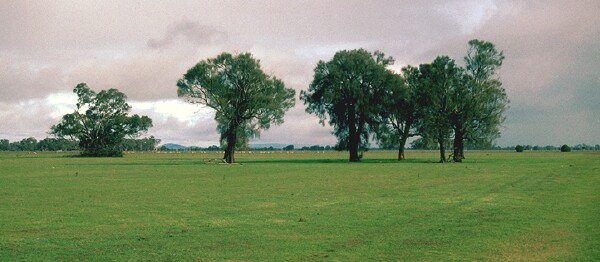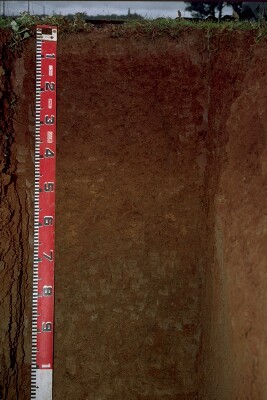LP86
| Group: Raywood Farm Advance Group | Australian Soil Classification: Hypocalcic, Mesonatric, Red SODOSOL |
| Northcote Factual Key:Dr 2.13 | Great Soil Group: red-brown earth |
| General Landscape Description: Old alluvial plain. Original vegetation included Yellow Box (Eucalyptus melliodora), Grey box (E. microcarpa) and Buloke (Casuarina luehmannii). | |
 LP86 Landscape |
Soil Profile Morphology
Surface Soil
| A1 | 0-6 cm | Strong brown (7.5YR4/6); light fine sandy clay loam; hardsetting surface condition; moderate fine blocky structure; pH 6.5; abrupt change to: |  LP86 Profile |
| Subsoil | |||
| B21 | 6-15 cm | Yellowish red (5YR4/6); medium heavy clay; moderate medium blocky, breaking down to strong very fine polyhedral structure (with smooth faced peds); very strong consistence dry; pH 7.6; clear change to: | |
| B22 | 15-35 cm | Reddish brown (5YR4/4); medium heavy clay; coarse blocky, breaking down to fine polyhedral structure (with smooth faced peds); very strong consistence dry; pH 8.5; clear change to: | |
| B31 | 35-60 cm | Strong brown (7.5YR4/6); medium clay; moderate fine polyhedral structure (rough faced peds); contains very few (2%) carbonate nodules in patches; pH 9.2; very strong consistence dry; clear change to: | |
| B32 | 60-85 cm | Dark yellowish brown (10YR4/4) and strong brown (7.5YR4/6); light medium clay; moderate coarse polyhedral, breaking down to moderate fine polyhedral structure (rough faced peds); pH 9.1; very strong consistence dry; clear change to: | |
| B33 | 85-100 cm | Yellowish brown (10YR5/6); fine sandy light clay; contains many dark flecks (manganese); pH 9.2; gradual change to: | |
| B34 | 100+ cm | Yellowish brown (10YR5/5); fine sandy light clay; pH 9.0. | |
Key Profile Features
- Strong texture contrast between surface (A1) horizon (20% clay) and subsoil (B21) horizon (53% clay).
- Sodic subsoil.
Key Profile Characteristics
pH | Salinity Rating | |||
Surface (A1 horizon) | slightly acid | very low | sodic | slight-moderate1 |
Subsoil (B21 horizon) | slightly alkaline | very low | sodic | strong |
Deeper subsoil (at 1 m) | strongly alkaline | low-medium | strongly sodic | strong |
| 1 Complete dispersion with remoulding. | ||||

Horizon | Horizon Depth | pH (water) | pH CaCl2 | EC 1:5 | NaCl | Exchangeable Cations | |||
Ca | Mg | K | Na | ||||||
meq/100g | |||||||||
A1 | 0-6 | 6.5 | 5.2 | 0.07 | 1.7 | 1.9 | 0.5 | 0.3 | |
B21 | 6-15 | 7.6 | 6.5 | 0.17 | 4.4 | 6.3 | 0.9 | 1.7 | |
B22 | 15-35 | 8.5 | 7.2 | 0.2 | 4.9 | 7 | 0.7 | 2.5 | |
B31 | 35-60 | 9.2 | 8.5 | 0.49 | <0.05 | 4.3 | 7 | 0.5 | 2.6 |
B32 | 60-85 | 9.1 | 8.5 | 0.67 | 0.05 | 3.4 | 6.3 | 0.5 | 3.1 |
B33 | 85-100 | 9.2 | 8.4 | 0.59 | 0.05 | 4.8 | 11 | 1.2 | 5 |
B34 | 100+ | 9 | 8.3 | 0.72 | <0.05 | 5.4 | 15 | 1.5 | 7.2 |
Horizon | Horizon Depth | Ex Al mg/kg | Ex Ac meq/100g | Field pF2.5 | Wilting Point pF4.2 | Coarse Sand (0.2-2.0mm) | Fine Sand (0.02-0.2mm) | Silt (0.002-0.02mm) | Clay (<0.002mm) |
A1 | 0-6 | 24.5 | 7.5 | 1 | 43 | 34 | 20 | ||
B21 | 6-15 | 29.2 | 17.1 | 1 | 20 | 21 | 53 | ||
B22 | 15-35 | 30.2 | 16.9 | 1 | 27 | 24 | 48 | ||
B31 | 35-60 | 31.1 | 17.1 | 0 | 37 | 27 | 37 | ||
B32 | 60-85 | ||||||||
B33 | 85-100 | ||||||||
B34 | 100+ |
Management Considerations:
Whole Profile
- Plant Available Water Capacity (PAWC) is considered to be low (estimated at 85 mm) for this site. This is based on available laboratory data and assumes an effective rooting depth of 50 cm. Rooting depth will be limited by the strongly sodic subsoil.
Surface (A) Horizon
- Due to previous soil loss under a different manager, the surface horizon is very shallow and does not provide much of a buffer zone to the sodic subsoil. Minimising further soil loss should be a prime objective.
- The surface horizon is hardsetting when dry and has a high fine sand (43%) and silt (34%) content. When cultivated dry, the soil will become "powdery" and the structure will break down. Tillage should be minimised and stubble retention/pasture rotations practised to build up organic matter levels. Organic carbon levels are moderate at this site. Improving organic matter levels will assist in minimising structural problems as well as improving soil fertility and water holding capacity.
- The surface horizon is sodic and disperses slightly to moderately. After remoulding, it disperses completely which suggests that excessive cultivation or overstocking of the soil in a moist to wet condition may result in the development of surface crusting and exacerbate the hardsetting condition. Raindrop action on bare soil will have a similar effect. Due to surface sealing, water infiltration will be reduced and seedling emergence restricted. Gypsum is usually an effective ameliorant on such soils. The use of gypsum will improve surface infiltration as well as seedling emergence.
Subsoil (B) Horizons
- The upper subsoil is strongly sodic and has a low calcium:magnesium ratio (i.e. <1). As a consequence it disperses strongly in water. This is likely to result in water and root movement being significantly restricted.
- The salinity rating becomes low to medium from 60 cm. This may restrict the growth of salt sensitive species (e.g. maize, linseed and faba beans).
- The subsoil is strongly alkaline (from 35 cm depth) which indicates that some nutrients (e.g. phosphorus, iron, manganese and zinc) may be poorly available to plants.
Comments from Landholder:
- Topsoil lost in the 1982 drought, (under a different manager).
- Stubble retention and direct drilling used.
- Gypsum used on neighbouring paddock with success. Infiltration of water improved significantly.
- Was heavily cropped for 20 years (crop/fallow regime), under a different manager.
Notes
- Profile described by Mark Imhof, Paul Rampant and Karen De Plater (5/7/95)


